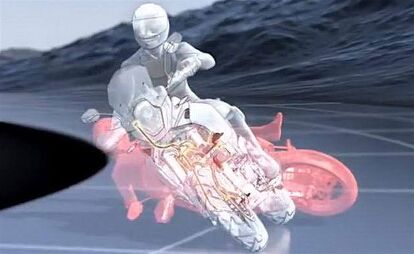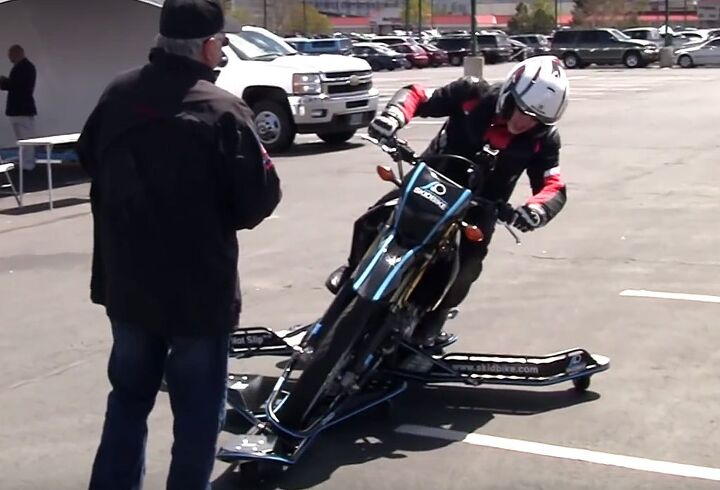MO Tested: Cornering ABS
Braking Until You See God Now Easier
If your occupation is testing motorcycles there’s a certain measure of accepted risk that comes with the job. When cornering ABS (C-ABS) arrived a couple years ago, the general consensus among the motojournos was, Hey that’s awesome, we’ll take your word for it working as described, because no matter how professional we try to be, grabbing a fistful of front brake mid-corner to evaluate this new technology is a line few were willing to cross. Just thinking of the action conjures images of impacting asphalt at a rate approaching lightspeed.
Attending the International Driver & Rider Training Symposium provided Kevin Duke and I the opportunity to safely explore C-ABS and all the mid-corner braking performance the technology promises to deliver. The result? Confirmation that we were not being lied to, and an elevated respect for the engineers and test riders who perfect this technology prior to making it available to OEMs for inclusion on the latest and greatest two-wheelers.
With a KTM 1190 Adventure outfitted with Cedergrens’ Skidbike contraption, Duke and I set to the task of crashing. Repeatedly, we failed. Grabbing a fistful of brakes while leaned over with the C-ABS functioning resulted with a rapidly decelerating motorcycle, and – once the initial I-shouldn’t-be-doing-this gag reflex was muted – no drama. Switching off C-ABS and replicating the act resulted as you’d expect, with the front wheel washing away, but minus the crash due to Skidbike’s outriggers catching our falls.
Technological Strategies To Motorcycle Safety
“I could throw the KTM into a corner and and roughly hammer the brakes without the front tire losing its grip and without blatantly obvious pulsing from the brake system – the bike simply scrubbed off speed at a rapid pace,” says Duke. “The only drama was gathering the nerve to brusquely apply the brakes, not the physics-defying electronic execution.”
As we experimented with stabbing the front brakes, as well as applying continually more brake pressure in a series of front braking threshold tests, C-ABS kept the front wheel from locking, allowing for controllable deceleration when a motorcycle might otherwise tend to stand up and go straight instead of maintaining lean angle and continuing its cornering arc. We were riding in a controlled area, but the advantages are obvious for any street rider who might, for example, get too hot into a decreasing-radius turn, or encounters an object mid-corner that demands avoidance. Knowing that you can, if required, apply a substantial amount of cornering braking force without fear of crashing is a huge mental benefit.
“Had I not found a career testing motorcycles,” Duke opines, “I could imagine myself being one of those know-it-all riders who scoff on multiple forums and social-media platforms at modern electronic rider aids, claiming that expert riders like myself could do a better job feeling out available grip with carefully trained fingers than a Bosch computer could. And I’d be very wrong. Not only could I not outperform C-ABS under ideal conditions, in an unexpected panic situation such as occurs on public roads, I’d be on the ground wincing from another broken clavicle.”
With the help of Skidbike, Duke and I were also astounded to learn just how much brake pressure the front tire would absorb before washing away when the C-ABS was turned off. “Riding on a not particularly grippy parking-lot surface, my mind half melted at the amount of braking force that could be applied to a leaned-over front tire before it lost grip and tucked,” says Duke.
The Magicians
Behind C-ABS and the myriad of other electronic rider aids are two German companies, Bosch and Continental. Both are engaged in the development of these technologies that, oftentimes, only differ on the outside by way of each company’s naming convention. The end result, though, is an increasing arsenal of motorcycle electronics meant to benefit motorcyclists from Adventure-Tourists to trackday speed junkies.
Cornering ABS – or Optimized Curve Braking (oCB) as Continental calls it – is realized by way of each company’s Inertial Measurement Unit (IMU), a phrase you’ve most likely encountered numerous times in various bike review articles. The IMU measures roll and yaw rates, lateral, longitudinal, and vertical acceleration rates, and – with the help of a microcontroller, wheel-speed sensors and other motorcycle-specific parameters – calculates lean and pitch angles. These measurements contribute to technologies such as traction control, launch control, wheelie control, hill-hold start, and accident detection. When combined with another technology such as ABS, the outcome is C-ABS and/or oCB.
“The system takes account of the fact that a motorcycle banks in curves”, says Lothar Kienle, Continental’s head of Development Motorcycle in the Vehicle Dynamics business unit. “The ABS kicks in more gradually, modulating braking pressure more smoothly to improve handling in curves.”
Presently, C-ABS/oCB are part of larger systems Bosch calls Motorcycle Stability Control), and Continental calls Motorcycle Integral Brake (MIB). Both systems utilize the available information from the IMU, and, in conjunction with a microcontroller and other sensors, combine to create a holistic system including ABS, C-ABS, TC, Launch and wheelie control, etc. The exact combination of available technologies are optional to needs of the OEM and the particular bike which is receiving the technology.
More often than not you’ll hear of these technologies disguised by manufacturer-branded identities, such as Ducati Safety Pack (DSP) or Kawasaki Intelligent anti-lock Braking System (KIPS), but make no mistake, behind the acronyms you’ll likely find Bosch or Continental.
And if you’re in the market for a new motorcycle, choosing one with some form of C-ABS or another is something we highly recommend.
A former Motorcycle.com staffer who has gone on to greener pastures, Tom Roderick still can't get the motorcycle bug out of his system. And honestly, we still miss having him around. Tom is now a regular freelance writer and tester for Motorcycle.com when his schedule allows, and his experience, riding ability, writing talent, and quick wit are still a joy to have – even if we don't get to experience it as much as we used to.
More by Tom Roderick






































Comments
Join the conversation
I don't need it. If I fail and decreasing radius it's because I didn't know it was there. ABS fails for me, too. What I need is a soft tire that will last me 20k miles. End of story.
you'll hear a lot of guys that race claim the abs makes them run wide in a corner when trial braking. they all want it gone...first thing they mod on all the new bikes with abs. they honestly think they can sense a wheel sliding more than electronic sensors can. lol. it's like saying they can do math faster than a computer. give it up guys, the system is activating because the tire is sliding. learn to use the systems to your advantage. it removes all the rider mistakes and worn tire issues. it's a useful tool. dont be like the old guy hanging on to the past.